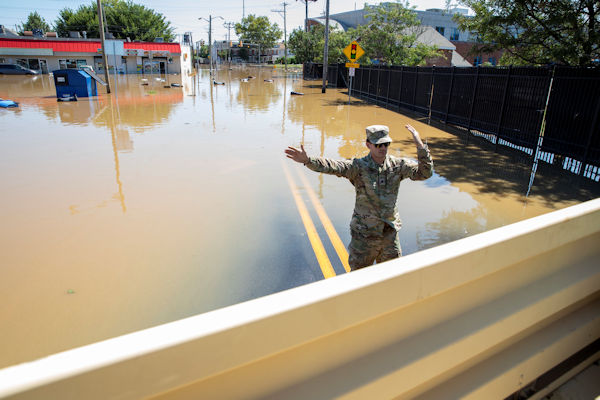SEJournal Online is the digital news magazine of the Society of Environmental Journalists. Learn more about SEJournal Online, including submission, subscription and advertising information.
 |
| Military installations make a huge local environmental impact. And, as the Army and other services react to climate change, that impact will change profoundly. Above, a Delaware Army National Guard member provides flood rescue support in Wilmington, Sept. 2, 2021, after heavy rains drenched the area. Photo: Army National Guard/Spc. Alyssa Lisenbe. Click to enlarge. |
TipSheet: New Army Climate Strategy Provokes Questions, Stories on Local and Regional Impact
By Joseph A. Davis
Carbon-free energy by 2030 on all of the U.S. Army’s 130 installations around the world.
Deployment by 2050 of all-electric tactical vehicles.
Microgrids for U.S. Army bases.
These are a few of the initiatives envisioned in the Army’s newly released climate strategy.
And if energy and environmental reporters know where to look, they’ll be able to use it as a guide to all kinds of local and regional stories.
Why it matters
In the United States alone, the Army runs scores of bases. The other branches of the military (Navy, Marines, Air Force, Coast Guard, etc.) have even more.
Any military installation makes a profound difference in the community in which it is embedded. Many local businesses are involved in supporting the base — whether via stores, services, logistics, transport, housing, or bars and restaurants.
Military installations make a
huge local environmental impact.
Each one also makes a huge local environmental impact. Even just looking at the peacetime, stateside part of the equation (we’ll deal separately with the geopolitics of how climate change will likely bring global conflict), there are more than enough environmental angles.
For instance, bases use a huge amount of electric power from the commercial grid. They may also use local water resources.
And, as the Army and other services react to climate change, that impact will change profoundly.
While nobody wants wars — and some say no one truly wins one — it is arguably best to win those we do fight. So, in that sense, planning for climate change will not only make U.S. fighters more effective, but may also save many lives.
The backstory
The national security community has been thinking about climate change for decades. But there has often been deep controversy (soldiers going abroad are supposed to win wars, not hug trees, right?).
Let’s face another reality: A lot of Republicans today don’t want to act on climate change (or even admit that it is real). They have repeatedly pushed back on the military’s efforts to factor climate change into national security.
President Biden, on taking office however, ordered the military to plan for climate change. Yet even since the Biden Pentagon came out with the Army Climate Strategy, GOPers have jumped to criticize it. Mike Rogers, top Republican on the House Armed Services Committee, called it “a waste of Department resources.”
Story ideas
- Check in with the public affairs office at your local or regional military base. Ask how the military’s climate strategies may affect them and the surrounding community.
- Find out how your local or regional base satisfies its electric power needs. How much comes from the commercial grid? How much backup power does the base have?
- What possible climate-induced extreme weather could threaten your local or regional base? The Navy complex at Norfolk, for example, is vulnerable to sea level rise. The Tyndall air base in the Florida panhandle sustained billions of dollars worth of damage in 2018’s Hurricane Michael.
- Look at the flood maps relevant to your local or regional base. A good start might be the Federal Emergency Management Agency Flood Map Service Center.
- Where does the water supply for your local or regional base come from? How is climate change likely to affect it? Will there be enough for both the base and the surrounding community?
Resources and recent reporting
- “US Army: Addressing Climate Change Threats,” U.S Army (May 14, 2021).
- “Department of Defense Climate Risk Analysis,” DoD (October 2021).
- “Pentagon Fuel Use, Climate Change, and the Costs of War,” Watson Institute, Brown University (June 12, 2019; updated and revised, Nov. 13, 2019).
- “How the World’s Militaries Hide Their Huge Carbon Emissions,” The Conversation (Nov. 9, 2021).
- “The U.S. Military Emits More Carbon Dioxide Into the Atmosphere Than Entire Countries Like Denmark or Portugal,” Sonner Kehrt, Inside Climate News (Jan. 18, 2022).
Joseph A. Davis is a freelance writer/editor in Washington, D.C. who has been writing about the environment since 1976. He writes SEJournal Online's TipSheet, Reporter's Toolbox and Issue Backgrounder, and curates SEJ's weekday news headlines service EJToday and @EJTodayNews. Davis also directs SEJ's Freedom of Information Project and writes the WatchDog opinion column.
* From the weekly news magazine SEJournal Online, Vol. 7, No. 7. Content from each new issue of SEJournal Online is available to the public via the SEJournal Online main page. Subscribe to the e-newsletter here. And see past issues of the SEJournal archived here.













 Advertisement
Advertisement 



